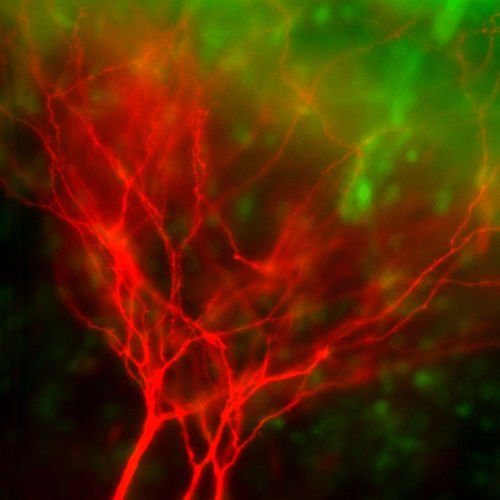
Above are pyramidal cells with fluorescent staining. The typical parallel configuration of the axons of such cells may be seen at the bottom of the photo.
- Problem:
Consciousness is characterized by unity (or unities).
Explanation: Consciousness is comprised of one or more electromagnetic fields, probably mostly electrical in nature.
- Problem (related to
the first problem): Information in consciousness apparently
interacts simultaneously with information close to it in "phenomenal
space" (colors interact, harmonies re-inforce, and edge effects are
striking and sometimes
illusory).
Explanation: While electrical fields have extensive effects, the strength of the field falls off from an individual nerve and action potential. Any strong and defined effect would normally be effective nearby.
- Problem: We
do not experience consciousness as being anything like our experience
with physical phenomena, so how can it be a physical phenomenon itself?
Explanation: We actually do not experience any physical phenomenon first-hand except consciousness. All other physical phenomena are representations within consciousness, marked as
4. Problem: We are not generally conscious of metabolic processes, but primarily are conscious of what is evidently neural information, the information encoded in our neurons. This is not a problem for our mind, since it probably is necessary for consciousness to make any sense at all. Yet it appears to be a "problem" needing explanation.
Explanation: This is where most "consciousness models" trip up badly, for if everything in general is conscious, or "quantum processes" are supposed to be conscious, it would be extremely difficult to explain the selectivity of consciousness. Information selected to exist in the nerves is what can be conscious (though much is not), and any explanation of consciousness must account for this. Electrical fields in the brain are likely to be dominated by information encoded in the nerves, so has the explanatory ability of a simply neural model, with the advantages of explaining 3-D interconnectivity via the electrical fields.
5. Problem: Consciousness needs to be tested quantitatively if it is to become genuinely a subject of scientific investigation:
Solution: While it may not be easy to investigate, consciousness as interacting electrical fields will be experienced as conscious information while it is simultaneouly available to be studied from a third-person perspective using quantitative methods. We may then compare information from both perspectives in order to discover whether or not consciousness is primarily a matter of electrical interactions, and if it is indeed, consciousness may be probed in the future from the third-person perspective alone.
6. Problem: Consciousness needs to fit into evolution.
Solution: Electrical fields are an unavoidable consequence of action-potentials existing within nerves, and interference would be unavoidable. Not only would evolution select against interference, it would simultaneously select for advantageous electric field interactions. These relatively coherent, yet interacting via differences in potential, sorts of electrical field interactions just happen to be the kinds of energy/information interactions which would produce statistically meaningful effects and registration within the complex electrical field, thus a sort of quantitative yet also qualitative register is produced within the electric fields. This we call consciousness.
|